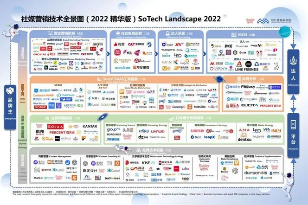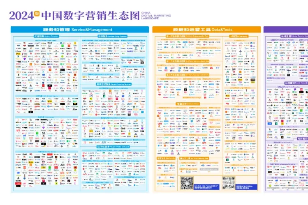「Future AI Talk」is a dialogue program co-sponsored by Marteker and Digital Frontier to explore the impact of the rise of generative AI on pan-marketing technology and marketing automation, in order to help the entire industry explore a new marketing path in the era of AIGC.

Interviewee: Shi Lan, Founder & CEO of Cocafe
Q: How do you understand the explosive growth of AIGC and Big models in 2023?
One of the most important points is that OpenAI has played an absolutely leading role in this process, especially with the release of ChatGPT, which became the first app in the world to reach 100 million users in the shortest possible time. Let everyone see that we are not that far away from AGI general AI. There are a lot of underlying capabilities in this, and it also brings tremendous value to many large enterprises, especially Microsoft. Whether it's the stock price, whether it's revenue growth, whether it's technology capabilities. Whether it is the United States, China or other parts of the world, powerful technology companies and entrepreneurs are rolling out big models. So I think this is a good thing for every single one of us, for people in the industry or entrepreneurs.
When we invest in roll technology, the growth and breakout time of applications is shorter. In the case of Cocafe, we apply AI to help reduce costs and increase efficiency, and put AI in customer-facing product design. Whether we can develop AI-native application products in the future should be based on the progress of underlying large model technology. So I believe that for everybody, as long as you join the trend, it's a good thing.
Q: In the application of marketing scenarios, what revolutionary changes will AI marketing have compared with traditional marketing methods? What disruption will it bring to marketing techniques and tools?
Shi Lan: The core change is in the content, especially the marketing scene, in the production, creation and dissemination of content, there has been a qualitative change. It turns out that all content production, creation, and distribution depend on these brain workers or knowledge creators.
We once thought that manual or repetitive work would be disrupted by AI. When AIGC and big models exploded, we found that creative content was affected first. Whether we are producing advertising content, graphics, video or multimodal, AI can greatly improve production efficiency. The degree of its improvement may not be the same, some are only in the stage of creating ideas, can shorten faster to reach the bottleneck point, and even until the end, that is, from the idea to the launch are implemented by AI, and the middle will be adjusted according to the feedback of the data. The extent to which each company applies it is different, but it is a great disruption to the creation and production of content, not just an increase in efficiency, but actually a model disruption. Maybe we didn't feel the difference between adopting AI and not adopting AI last year, but after next year, those companies that don't adopt AI technology will be eliminated. Just like the difference between companies that participated in e-commerce and those that didn't.
There has also been a qualitative change in the transmission and reach and feedback of data. We used to say thousands of people, in fact, it is still not true that everyone is different. Now there is a large AI model, if we continue to iterate in computing power and large model technology, we can really customize personalized content for everyone in the future. And content may even be produced in real time. When I watch a short video stream push, what I see, my actions, and my interaction with the short video determine what I see in the next second. It's being generated in real time, and we can imagine a future where it's completely tailored to what everyone wants to see, or what you want to push to them.
Of course, from another perspective, it's also a terrible thing. We're in a big information cocoon right now. A lot of media content, short video algorithm recommendation, so that the young generation of children's thinking power declined. Our minds are often more extreme in the information cocoon. In a way, we too are in the hands of AI. Technology takes advantage of the weakness of human nature to keep delivering what the audience wants to see, or what it wants the audience to see, and then the audience gradually becomes addicted. This is also one of the risks of our AI, which is how AI is more ethical, more valuable, and more friendly to the future of humanity.
On the other hand, if the audience really has the kind of Super Power in science fiction behind it, its penetration of ideas is imperceptible. That's why we say all companies, all people should be involved in AI. You shouldn't be the passive recipient. Only if you participate in the game, together to help shape the rules of the game, put forward your requirements, put forward your boundaries, those technology companies, those R & D personnel will respond. In this process, each individual should express his or her own voice, and that voice should be in a positive direction together.
Cocafe is a marketing technology company that develops application-oriented products for enterprise customers based on AI. But I don't think customers can just passively accept it and choose whether they want it or not. In fact, the customer is a very important force in this process, that is, the customer to put forward requirements, needs, and boundaries. It is complementary, all of our product design should be based on user needs to do feedback. If the user does not demand, we will be more dominant, and sometimes we will take more detours. So I think this is a process of mutual cooperation and co-creation.
Q: For marketing technology companies, how do AI-transformed technology products compare to their predecessors?
Shi Lan: The first is to improve efficiency. It turns out that when we produce a video, if we use the traditional TVC shooting method, the cost of a video is calculated in seconds, and it may be as high as thousands of yuan per second. If you finish shooting, say no, change some in the middle, and start the whole shooting process from scratch. Now we use 3D models and AI scripts to generate videos, and the cost is reduced by two orders of magnitude, such as the original 1,000 yuan, now only 10 yuan. And the adjustment is very convenient, only need to drag back and forth on the computer screen, adjust the Angle or switch the screen, I do not need all the props, lights to re-place, re-shoot, so it is definitely reduced in cost. The reduction in cost actually leads to an increase in possibilities. The original budget can only do three directions, now can try 3000 directions, I put these 3000 directions on the market, and then according to the data feedback, choose the best 30 among them, so as to bring revenue growth.
The biggest impact of AI on us is not just in the content and delivery of our work, but in our thinking. We are acutely aware that this is the "fourth technological revolution" that will create enormous amounts of wealth over the next 20 years, a turning point for the fortunes of every company and individual. If you catch the trend, just like 10 years ago you got the mobile Internet ticket, 20 years ago got the Internet ticket is the same. As a marketing technology company, we are also thinking about how to improve the existing business, and whether it is possible to build products that are native to AI, based on large model technology, and based on the gradual maturity of existing apis. It may not be the product we have today, but it creates a lot of value. We're always exploring. We're always trying.
Q: What conditions do you think need to be met for AIGC to achieve its capabilities?
Shi Lan: The marketing scenario is exactly the scenario that AIGC can play very well: First, its requirements for the result are open and creative, rather than having only one right answer, because the large model must have illusions; Second, it has a relatively high tolerance for risk. If we use it in the medical or legal field, it has a relatively low tolerance for risk, even if it makes a mistake of one in 10,000, it may be a great risk. But there is no such problem with marketing content creation.
What are the key factors in the middle, of course, the first is the quality of the underlying model itself. GDP3.5, GDP4 and the upcoming GPT5, compared with the domestic Chinese model, there is a gap in content creation ability; The second is computing power, and now the cost of computing power is more expensive, so we have to calculate, generate with AI and other ways, compare the cost of large models and small models, which is more cost-effective. Only when the cost reaches a critical point can there be a large-scale explosion of applications.
Again, the most critical point is good data. Whether it is at the training level of the model, or fine-tuning the existing model, whether there is good data, which can produce better results, will also affect the cost of use to some extent. When you have really good data, and you combine the big model with the data, and you do small vertical models, you get better underlying technology. This is based on good data. This is why the industry believes that traditional companies with a lot of customer data are more likely to succeed because that data is not public data.
In fact, we believe that for entrepreneurs or practitioners, the most critical is the ability of people. The underlying technology, computing power and data cannot be changed, but human abilities can be changed. If everyone in the whole team loves learning very much, thinks that AI is very important, takes the initiative to use these AI applications, you are very keen to catch all technical iterations, and you have been positive feedback and positive cycles, you will be a tidal wave in the middle of the trend.
As a leader, we must have the ability to recognize this trend, drive the organizational and technological change of the entire company, and let every member of the team have this ability, and finally all the work is done by the team. For individuals, they must always challenge themselves, do not repeat the original path, and constantly challenge the inherent pattern. The ability to ask questions about ChatGPT, for example, has a lot to do with the boundaries of your knowledge and the depth of your thinking. When you know absolutely nothing about a subject, it's impossible to ask questions about it. You don't think deeply enough to ask deeper questions; The big model is a treasure, and how much you can gain from it has a lot to do with your own ability.
Q: What new challenges do brands face with the emergence of AIGC?
Shi Lan: From a brand perspective, the first challenge is whether the company or brand can become a company or brand capable of using AI. The company where a brand is located is very large, and the personnel have different functions and different knowledge and ability backgrounds, so that everyone can use AI, which is the first challenge.
Second, but also more specific challenges, such as our service customers, many frontline international brands, the final content requirements cannot be created by AI. Because of the definition of intellectual property rights and the protection of IP, there are many vague areas, and first-line brands have stricter control over risks. We may only use the first 80% of AI capabilities, and the last 20% must ensure that every one of them is active, and that all the data used for training in the process is legal, is it authorized enough, and is it risky? A lot of it is twilight zone.
In order to avoid risks, big brands need to cultivate another ability, how to run a closed loop between compliance innovation and application effect, in a way, it is also a test of the organization's ability to adapt to market changes. When companies face technological change and legal boundaries are not immediately clear, companies that quickly implement iterative change will have different results.
Third, each company, each brand has a different data base, there is already a very good digital foundation, users have been labeled, products have labels, there are material libraries, on this basis, quickly generate a lot of things with AI, or touch constantly get feedback. Some even have no digital foundation, cannot use AI out of thin air, first of all to make up the lesson of digital foundation.
Q: Does the penetration of AI technology in brand marketing mean that marketers need to update their expertise? How can marketers respond to this change and build resilience for the future?
Shi Lan: The first thing to realize is that this is a must, not to say that it is good, you have to learn these technologies, understand these technologies, it is possible to apply. It is not that you can find a technical person to cooperate, if you do not learn at all, even the ability to ask large models will not be very good.
Secondly, we need some basic skills, at least to know what AI can do, what AI can't do, what AI is good at, what AI is not good at, and where are the boundaries? To what extent is AI capable? Then know how to talk to technical personnel or technical service providers to effectively raise demand.
Third, all the results created, how to convert into ROI, so that consumers, so that my boss can see, there will be more budget investment next year. Therefore, layer by layer, from the level of consciousness, to grasp the basic technical concepts, concept boundaries, know how to apply, and finally get the results to achieve transformation, there are ability requirements.
Q: How has the economic downturn affected the adoption of AI capabilities?
Shi Lan: To some extent, the economic downturn has promoted the development of AI. When the economy is down, everyone's first consideration is to reduce costs and increase efficiency. AI is a kind of productivity, can replace the production capacity of all aspects, so we will first from the perspective of reducing costs, for example, the original team needs 10 hands, now AI can replace two hands, the cost is reduced by 20%. So first of all, from the perspective of reducing costs, people will adopt AI.
In addition, during the economic downturn, many people who are unemployed or have difficulty finding work will choose to become super individuals. He can choose the AI to help him become a team. These factors are driving the AI project.
Of course, the adoption of a new technology, the company will certainly have to invest, such as external procurement of relevant capabilities or services, or to improve and enhance the existing team, but also need a certain cost. Companies are willing to try new technologies when they have the budget. But the economic downturn has affected budgets, and companies will put higher demands on technology providers, who must see results or have good reasons to adopt new technologies.
Q: How will AI affect the development of the metaverse?
Shi Lan: It's definitely a good thing in terms of content creation. An important bottleneck in the meta-universe is that there isn't enough content. AI can create more content. In particular, a lot of content in the meta-universe is 3D, the production cost is high, and it is difficult to rely on ordinary users or professionals to produce, but it is feasible with AI. So a lot of game companies use AIGC because they see results first, and of course it doesn't have to have very clear boundaries like the real world. In addition, AI can help the meta-universe arrive earlier, so that more economic systems in the middle can run through, and there are incentives for users. As users move from 2D to 3D, from offline to always-on, the cost will increase, so what's the return? AI could offer even more rewards. For example, we and some cultural tourism projects do cultural tourism meta-universe, will place some souvenirs or content created by AIGC, by consumers or scenic spots to pay for, users are willing to make more investment in the meta-universe.





 Marteker .2024-02-28 09:52.阅读量.911
Marteker .2024-02-28 09:52.阅读量.911






